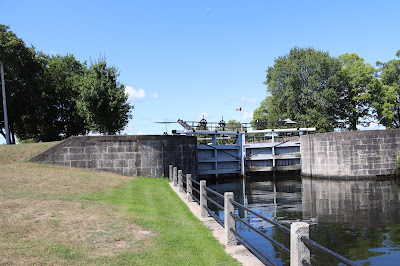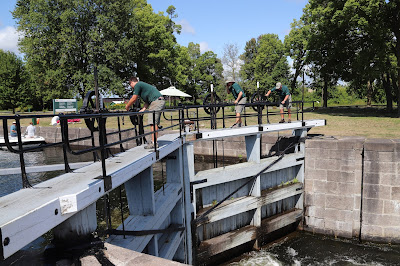The Smiths Falls Detached Lockstation occupies the south side of Duck Island west of Abbott Street North and north of Lombard Street. The part of Abbott Street that goes over the canal channel is a swing bridge and makes it part of the lockstation.
Parks Canada
Rideau Canal
National Historic Site of Canada
Smiths Falls Detached Lock
Parcs Canada
Canal-Rideau
Lieu historique national du Canada
Écluse détachée de Smiths Falls







SMITHS FALLS DETACHED
The quiet lockstation is located on the south side of Lock Island. On the north side of this island a waste weir (water control dam) was built to control the level of the Rideau River upstream of this lock.
A significant feature in their area is the Scherzer Rolling Lift Railway Bridge, a type of bascule bridge, located 170 metres (350 feet) upstream of this lock. This massive structure was built in 1914 for the Canadian Northern Railway and served until the line ceased operation in 1984.
The Rideau Canal Waterway was built for the military defence of Canada, but it never saw military action. It quickly became a major commercial route, allowing the easy transportation by water of goods from the region to markets in commercial centres such as Montreal and Toronto. The coming of the railways in the late 1800s marked the decline of the Rideau as a commercial waterway. Smiths Falls became a major railway hub, serving as the regional centre for the Canadian Pacific Railway. By the early 1900s, recreational boats were replacing commercial barges and steamers, transforming the Rideau into the recreational waterway we see today.
Between 1826 and 1832, an old Indian canoe route along the Rideau and Cataraqui Rivers was transformed at the command of the British government from untamed wilderness rivers into the Rideau Canal. The purpose of this remarkable artery was to provide the British army with a safe route for supplying its inland garrisons, avoiding the direct but exposed route along the St. Lawrence, which only the disorganization of the American forces had prevented from being cut during the War of 1812.
The 202 km (126 miles) of waterway was made navigable by 47 locks grouped in 24 stations with their associated dams and weirs. The word was designed and superintended by the Royal Engineers, commanded by Lieutenant Colonel John By; the actual construction was done by local contractors.
Despite the blockhouses along the waterway, the role of the Rideau has always been peaceful. It was a busy waterway, carrying settlers and supplies into the growing settlement of the interior until the middle of the 19th century, when larger locks were opened on the St. Lawrence. At the same time, since the possibility of war between Britain and the United States was now unlikely, the British Board of Ordnance signed the system over to the colonial government of Canada in 1856. The period of the Canal's military administration was over.
Local commercial traffic remained important until the advent of the automobile and better roads about the time of World War 1. Since that time recreational boating has grown steadily so that now the system, well into its second century, is busier than ever.

SMITHS FALLS (DÉTACHÉE)
Ce poste d'éclusage paisible se trouve sur la rive sud de l'île Lock. Un déversoir (barrage de contrôle du niveau d'eau) fut construit sur la rive nord de l'île pour maîtrisier le niveau de la Rideau en amont de l'écluse.
Un des attraits de cette région est le pont basculant roulant, ou pont Scherzer, situé à 107 mètres (350 pieds) en amont de l'écluse. Le Canadien Northern construisit cette structure massive en 1914 et l'utilisa jusqu'en 1984, année de fermeture du tronçon.
La canal Rideau fut construit pour assurer la défénse du Canada, mail il n'a jamais servi à cette fin. Il est rapidement devenu une importante voie de commerce maritime, puisqu'il facilitait le transport par eau des marchandises des régions vers les marchés de grandes villes comme Montréal et Toronto. L'arrivée du chemin de fer à la fin des années 1800 entraîna le déclin du canal en tant qu'artère commerciale. Smiths Falls devint un centre régional d'envergure du Canadien Pacifique. Au début des années 1900, les embarcations de plaisance remplacèrent les barges et les vapeurs commerciaux, faisant du canal Rideau la voie de navigation de plaisance que nous connaissons aujourd'hui.
Entre 1826 et 1832, une ancienne voie d'eau utilisée par les Indiens le long des rivières Rideau et Cataraqui fut transformée à la demande du gouvernement britannique en un réseau de voies navagables : le canal Rideau. Le but de cet ouvrage remarquable était de fournir à l'armée britannique une route sûre pour approvisionner ses garnisons. On évitait ainsi le Saint-Laurent, voie plus directe mais oussi plus dangereuse qui n'était demeurée ouverte qu'en raison de la désorganisation de l'armée américaine au cours de la guerre de 1812.
Le réseau de 202 km (126 milles) a été rendu navigable par la construction de 47 écluses regroupées en 24 postes. Les travaux ont été planifiés et surveillés par les Royal Engineers. Sous le commandement du lieutenant-colonel John By. Ils ont été exécutés par des entrepreneurs locaux.
Malgré les blockhaus qui se trouvent le long du réseau, le Rideau n'a jamais été troublé par la guerre. Ce fut un cours d'eau achalandé transportant colons et approvisionnement à l'intérieur des terres jusq'au milieu de XIXe siècle lorsque les grandes écluses du Saint-Laurent furent ouvertes à la navigation. Au même moment, la menace de guerre entre la Grande-Bretagne et les États-Unis s'étant estompée, le British Board of Ordnance céda le réseau au gouvernement colonial du Canada en 1856. Ceal mit fin à l'administration militaire du canal.
Le trafic commercial local demeura important jusqu'à l'apparition de l'automobile et la construction de meilleurs routes à l'époque de la Première Guerre mondiale. Depuis, les plaisanciers se sont faits de plus en plus nombreux, tant et si bien qu le réseau, qui en est à son deuxième siècle d'existence, et maintenant plus fréquenté que jamais.

































Very soon after tying up in the lock the dog leapt out of the boat and went for a swim. I should have taken more pictures. Of course, the operation of the lock must stop until the dog was recovered from the water. The delay seemed much longer than it actually was.
I said to one of the lock workers, "You must see this kind of thing quite often."
He said, "I've been working here for ten years. I've never seen this happen before."









































































































